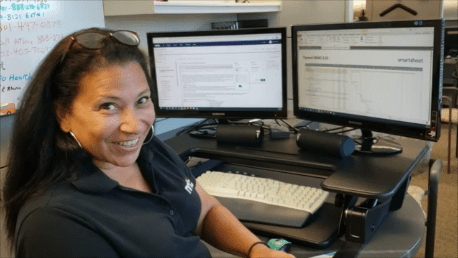How to Effectively Manage and Support Work-from-Home Employees
Fiona Ballard
|
First, thanks to all who attended my April 9 webinar covering the challenges of managing teleworkers during the COVID-19 pandemic. As we learned, it’s difficult to stay connected during this current reality, but it’s not impossible. We are a communications organization above all else, so it’s gratifying and brings me hope that we will continue to communicate with you—and help you communicate with others—even when we can’t be together.
For those who were unable to attend, I have a few tips on how to stay productive, connected, and anxiety-free while we telework. Specifically, I’m speaking to managers who are both learning as they go and trying to manage employee schedules, concerns, and connectivity.
Isolation presents so many obstacles, but many can be overcome if we just remember to stay in touch. Communication is good; over-communication is better. Try to imagine all those two-minute conversations you have with colleagues throughout the day. Stops by the watercooler, meetings, lunches, or even quick chats in the parking lot—all gone now that we’re working from home. Ensure you’re communicating enough and in the right way:
- Engage regularly – Ideally, you should have three touches with each employee every day. Emails, phone calls, texts, IMs, virtual meetings or a video calls will give employee plenty of opportunities to engage, ask questions and be heard.
- Establish a strategy and stick to it – The main goal is to maintain team cohesion. Find the structure, activities (individual and group) and goal setting hold your employees together as a unit and always return to that strategy if you start to lose your way.
- Communicate clearly – Video meetings are a great way to stay professional and put a face to a name, but if you have a spotty connection and lose audio, politely end the call and try again later. The only thing worse than no communication is poor communication.
Working from home provides plenty of distractions, especially as most of the country’s kids are also learning from home (often with parents’ help). But there are ways to help your employees stay on task:
- Set clear expectations – Provide hard deadlines for projects, schedule regular progress reports and celebrate completion.
- Stick to a schedule – Remind employees of their core hours and continue to hold regular meetings. This is not one long snow day. Avoid suggesting we “wait until we get back” to hold meetings or virtual events.
- Focus on one thing at a time – Don’t make employee lives too difficult by assigning multiple projects at the same time. When possible, oversee one project start to finish before assigning something new.
Most importantly, make sure that employees are handing the isolation well physically and mentally. Especially for those employees who already suffer from depression, anxiety, PTSD or other mental health issues, stay in touch and recognize signs that they are struggling.
- Stay equipped – Check in to make sure employees have the equipment and technology they need to do their jobs. Nothing stirs up anxiety like needing something and not having it.
- Encourage breaks – Remind employees to get out for a walk around the block, meditate, drink plenty of water and eat healthy. Anything we can do to boost immunity and keep a healthy body and clear mind right now helps.
- Be flexible and understanding – You’re managing a team which is a lot, but your employees are managing their jobs, households and potentially health issues. Be accommodating of altered schedules, changes in plans and the occasional child zooming through the background of a video call.
NRTC members who would like to hear the entire webinar may listen to a recording of the event. We plan to hold our next webinar with cybersecurity tips for work-at-home teams on Thursday, April 23. NRTC members can register today.
Fiona Ballard is VP, Human Resources for NRTC Managed Services.


